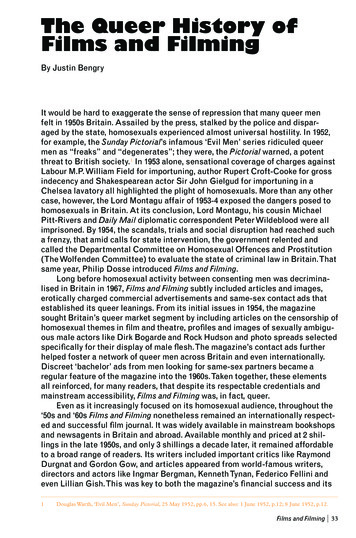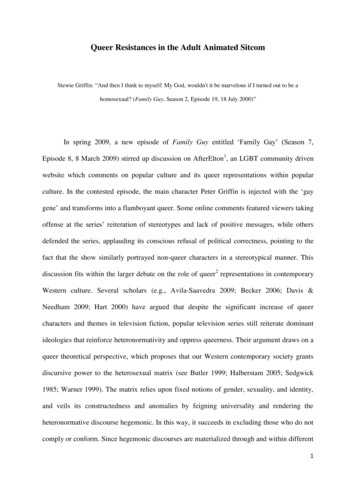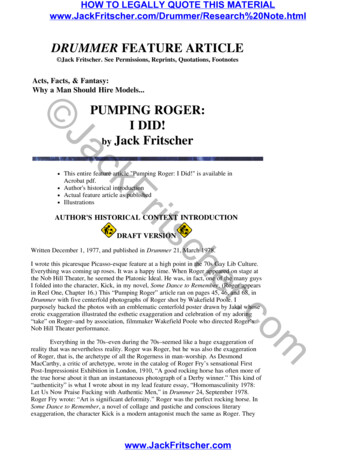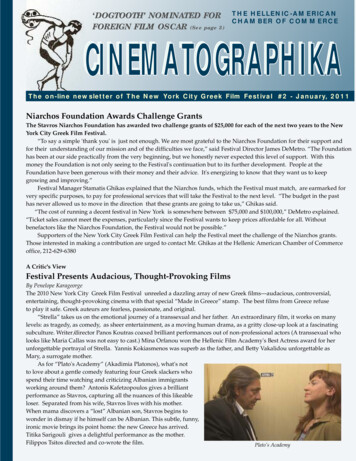
Transcription
The Queer History ofFilms and FilmingBy Justin BengryIt would be hard to exaggerate the sense of repression that many queer menfelt in 1950s Britain. Assailed by the press, stalked by the police and disparaged by the state, homosexuals experienced almost universal hostility. In 1952,for example, the Sunday Pictorial’s infamous ‘Evil Men’ series ridiculed queermen as “freaks” and “degenerates”; they were, the Pictorial warned, a potentthreat to British society.1 In 1953 alone, sensational coverage of charges againstLabour M.P. William Field for importuning, author Rupert Croft-Cooke for grossindecency and Shakespearean actor Sir John Gielgud for importuning in aChelsea lavatory all highlighted the plight of homosexuals. More than any othercase, however, the Lord Montagu affair of 1953-4 exposed the dangers posed tohomosexuals in Britain. At its conclusion, Lord Montagu, his cousin MichaelPitt-Rivers and Daily Mail diplomatic correspondent Peter Wildeblood were allimprisoned. By 1954, the scandals, trials and social disruption had reached sucha frenzy, that amid calls for state intervention, the government relented andcalled the Departmental Committee on Homosexual Offences and Prostitution(The Wolfenden Committee) to evaluate the state of criminal law in Britain. Thatsame year, Philip Dosse introduced Films and Filming.Long before homosexual activity between consenting men was decriminalised in Britain in 1967, Films and Filming subtly included articles and images,erotically charged commercial advertisements and same-sex contact ads thatestablished its queer leanings. From its initial issues in 1954, the magazinesought Britain’s queer market segment by including articles on the censorship ofhomosexual themes in film and theatre, profiles and images of sexually ambiguous male actors like Dirk Bogarde and Rock Hudson and photo spreads selectedspecifically for their display of male flesh. The magazine’s contact ads furtherhelped foster a network of queer men across Britain and even internationally.Discreet ‘bachelor’ ads from men looking for same-sex partners became aregular feature of the magazine into the 1960s. Taken together, these elementsall reinforced, for many readers, that despite its respectable credentials andmainstream accessibility, Films and Filming was, in fact, queer.Even as it increasingly focused on its homosexual audience, throughout the‘50s and ‘60s Films and Filming nonetheless remained an internationally respected and successful film journal. It was widely available in mainstream bookshopsand newsagents in Britain and abroad. Available monthly and priced at 2 shillings in the late 1950s, and only 3 shillings a decade later, it remained affordableto a broad range of readers. Its writers included important critics like RaymondDurgnat and Gordon Gow, and articles appeared from world-famous writers,directors and actors like Ingmar Bergman, Kenneth Tynan, Federico Fellini andeven Lillian Gish. This was key to both the magazine’s financial success and its1Douglas Warth, ‘Evil Men’, Sunday Pictorial, 25 May 1952, pp.6, 15. See also: 1 June 1952, p.12; 8 June 1952, p.12.Films and Filming 33
appeal to many gay men. Editor Robin Bean once explained his vision for Filmsand Filming to a contributor: “Gay men who were in the closet, especially thosewho still lived at home with their parents or were married, could openly sit onthe tube or a bus or in school or the office and be viewed reading the magazinewithout fear of anyone suspecting they were gay.”2Films and Filming began in October 1954 as part of a stable of seven artstitles put out by Philip Dosse’s Hansom Books.3 More sophisticated than fanmagazines, but less intellectually demanding than the British Film Institute’sSight and Sound, Films and Filming soon became the publisher’s most successfultitle.4 By the early ‘60s, circulation was above 40,000 according to one contributor.By comparison, sales of Sight and Sound only reached 30,000 by 1969.5 The danceexpert Peter Brinson was first to edit Films and Filming but was soon replaced byPeter Baker, who would remain at its helm throughout much of the ‘50s and ‘60s.6His assistant, Robin Bean, played a pivotal role in the magazine as its last editorunder publisher Philip Dosse from 1968. Described as a “cheeseparing eccentric”, Dosse himself remained an enigmatic figure throughout his tenure as publisher, largely unknown to contributors and even to some of his editors.7 But itwas Dosse, most contributors agree, whose vision guided the magazine to seeka queer audience, suggesting articles that would allow editors to get more “dollyboys” on the cover.8 This made good financial sense, ensuring that Films andFilming remained Dosse’s leading title, even subsidising his other publications.One contributor remembered that, “Having Alain Delon [in Plein Soleil] on thecover with his shirt off was said to have produced an increase in sales, and having Charlton Heston taking his pants off [in Big Country] sent them soaring.”9Some businesses soon recognised the magazine as a place to access aspecifically queer market; ads for Vince Man’s Shop, a notoriously queer Sohomen’s boutique, began appearing in December 1954, only the magazine’s thirdissue. They appealed to homosexual men with coded language and suggestiveimages that many would have recognised.10 Unsurprisingly, the aesthetic ofthese ads, male models posed in revealing swimwear and tight garments, bore astriking resemblance to the physique photography Bill Green (a.k.a. Vince) hadproduced during his period as a beefcake photographer. This aesthetic, alreadycoded as queer by virtue of its appearance in physique magazines and eroticprints, immediately spoke to homosexual men with a familiar visual language.2345678910Michael Armstrong, correspondence with author, 13 October 2010.Little has been written of the history of Films and Filming. Two short articles have appeared in the UK queer and filmpress. On its deliberate appeal to queer consumers, rise and ultimate decline see: Haydon Bridge [David McGillivray],‘Seeks Similar’, QX International, 30 June 2004; David McGillivray, ‘Goodbye To All That’, Films and Filming, March1990, pp.4-5. Haydon Bridge is the pseudonym of film critic and screenwriter David McGillivray, who wrote forFilms and Filming for 25 years beginning in 1966. David McGillivray, correspondence with author, 5 November2009. A more extensive discussion does, however, appear in Italian. See Mauro Giori, ‘ “Una rivista equilibrata perspettatori intelligenti”: Appunti per una storia di Films and Filming (1954-1990)’ [‘ “A sensible magazine for intelligentfilmgoers”: Notes for a history of Films and Filming (1954-1990)’], Paragrafo V (2009), pp.57-88.Hansom Books’ other titles included: Art and Artists, Books and Bookmen, Dance and Dancers, Music and Musicians, Playsand Players, and Records and Recording.Barry Pattison, correspondence with author, 14 September 2010. On Sight and Sound see Anthony Slide, ed.,International Film, Radio, and Television Journals (London, 1985), pp.327-329.Ken Robinson, ‘Brinson, Peter Neilson (1920–1995)’, Oxford Dictionary of National Biography, Oxford University Press,Sept 2004 [http://www.oxforddnb.com/view/article /59783, accessed 16 Sept 2010].Peter Roberts, ed., The Best of Plays and Players, 1953-1968 (London, 1987), p.7.David McGillivray, interviewed by Justin Bengry, 2 April 2010.Barry Pattison, correspondence with author, 11 September 2010. Charlton Heston appeared on the August 1958 cover,while Delon in Plein Soleil appeared in October 1960. Delon, a favourite with the magazine’s queer audience, appearedregularly.On photographer turned boutique owner Bill Green (Vince) and his influence on the development of SwingingLondon’s Carnaby Street revolution in menswear see Justin Bengry, ‘Peacock Revolution: Mainstreaming Queer Stylesin Post-War Britain, 1945-1967’, Socialist History 36 (2010), pp.55-68. Special issue on Gender and Sexuality.34 Little Joe
Films and Filming 35
36 Little Joe
Vince’s April 1955 ad for ‘Capri style jeans’ focused as much on the modelas the product. He was posed looking away from the viewer, inviting unselfconscious gazes at his bum, which was deliberately placed at the very centre of theadvertisement. Besides the jeans, the ad also advertised his 1955 leisurewearcatalogue, sent on request, presumably showing more of the model in less.Queer journalist and playwright Peter Burton remembers that Vince’s “catalogueof swim- and underwear could almost be classified as an early gay magazine.”11In Vince’s June 1958 ad, all subtlety was gone. Displaying the cultivated bodiesof physical culture and wearing only the small briefs for which Vince was by thenknown, images of the ad’s two men were cropped for fullest effect. The two models were positioned looking only at each other, now the objects of each other’sgazes, offering potential sexual tension between the men within the ad itself. ByJuly 1959 Vince’s ad for the ‘New Striped Swimbrief’ showed a model more likea homoerotic physique print than ever before. Here Vince’s brief left none of themodel’s anatomy to the imagination, his genitals discernible beneath the fabricof the brief swimming costume.12Films and Filming appealed to its queer market segment in still other ways.Producers rarely missed an opportunity to print film stills of naked torsos orsteamy glances between men. But in addition to the men who regularly peppered the magazine, a July 1960 article also stands out. ‘The Money in Muscles’described at length a ‘Beefcake Invasion’ among recent Italian-made films.13Tellingly, homoerotica could also be bought in the classified ads. In one 1965 issue, an ad requested “A.M.G. 8mm Films new or used.”14 Likely referring to materials produced by the Athletic Model Guild, Bob Mizer’s California beefcakeproduction company, the poster was in luck; conveniently, just a few ads below,C. Baxter offered a “Large Quantity of A.M.G. and similar material for disposal.”The magazine’s small ads were a veritable queer marketplace.Extending well beyond consumer goods, however, Films and Filming becamemost renowned for its contact ads.15 Throughout the ‘50s and ‘60s an increasing number of same-sex personal ads suggest the stability, even the growth, ofthe magazine’s queer market segment. Indeed, by the late ‘50s and throughoutthe ‘60s most of the magazine’s Market Place section comprised ads from men,carefully coded and suggesting homosexual desires, seeking same-sex companionship. Commenting on Films and Filming, John Stamford of Brighton, founderof the physique magazine Spartacus and later the Spartacus Gay Guide, remembered the classified section growing from just a few adverts to one and a halfpages of them by the mid-‘60s.16Michael O’Sullivan, who worked for Films and Filming in the ‘70s, remembersfirst finding the magazine in 1962 at the age of 16. He made sure to get copiesmonthly after that, soon recognising the magazine’s queer slant and opportunities to make contact with other men. O’Sullivan even sent in an ad himself at17 while still living with his parents in Ireland. Replies arrived from all over the111213141516Peter Burton, Parallel Lives (London, 1985), p.30.A similar ad from Vince in April 1956 showed a young Sean Connery modeling the ‘New Vince Capri Shirt’, as well asvery slim and very short ‘Jean Shorts’ that left little doubt that Mr. Connery dressed to the left.John Francis Lane, ‘The Money in Muscles’. Films and Filming, July 1960.Films and Filming, December 1965.See Bridge, ‘Seeks Similar’ for an overview and examples of ads from Films and Filming. Bridge attributes to Films andFilming the first examples of modern gay contact ads. H. G. Cocks, Classified: The Secret History of the Personal Column(London, 2009), however, shows such ads appearing across publications throughout the century.Pat [John Stamford], Interviewed by Tom Sargant, 10 February 1991. Brighton Ourstory Oral History Collection,Brighton, UK.Films and Filming 37
world. When O’Sullivan moved to London in 1965, as a young gay man he againturned to Films and Filming, knowing he could use its contact ads to find friendsand shared accommodation in the city. “It did have a considerable influence onmy life” he remembers.17The magazine’s queer network even extended overseas. In May 1965, PeterBonsall-Boone was already familiar enough with the British magazine to placea personal ad knowing it would reach its intended audience. A self-described“active young bachelor” from Victoria, Australia, Boone’s ad described him as“interested in most things.” He was also interested in finding similar young men.Two “bachelors” living in Ealing placed an ad in the same issue. Not surprisinglytheir interests included cinema – but also wrestling! They sought “male friends”,aged 25 to 30, who were encouraged to respond with photos. This last condition was declared “essential”. A “Young, Versatile Ex-Matelot”, a “Presentableyoung designer”, an “Unconventional Bachelor” and “A Nice warm, sensitivemale”, among others, all sought the same thing in the back pages of that issue.Still others, like that of a “gay and versatile” young man who sought “interesting, remunerative” work, were less circumspect – “anything legal considered”he added.When Robin Bean took over the reins in 1968 the magazine changed substantially. He had little concern with the magazine’s articles, but as a photographer was most interested in its visual content. Through his contacts, Bean hadexclusive access to film sets, securing stills and photos that appeared nowhereelse, then or since. Films and Filming’s photo spreads at this time were internationally renowned. For a time, the magazine’s critics still secured interviews withcinema’s brightest stars.18 But under Robin Bean’s editorship, the magazine alsobecame infamous for more explicit homoerotic imagery. Many film enthusiastsbegan to lose interest and the publication’s sales sagged through the ‘70s. Nolonger satisfied with bare chests and suggestive poses, the magazine includedincreasing amounts of nudity, even including full-frontal male nudity on somecovers. At the same time the quality of its film content diminished precipitously.In its final years, the magazine alienated the three key markets that hadmade it both respected and successful. Film buffs lost interest as the strengthof its cinema commentary waned. Gay men interested in Film and Filming’s eroticcontent no longer needed the magazine as explicit erotic publications becamemore available in the ‘70s. Finally, its readership of discreet or closeted gay menwho had been a mainstay of the magazine’s readership in the ‘50s and ‘60s couldno longer read Films and Filming at the office or on the tube, as Robin Bean hadonce claimed. It was simply too compromising. David McGillivray remembersother Films and Filming writers no longer even wishing to be seen reading themagazine in public, instead hiding it among the pages of The Guardian. One evengrumbled “I don’t know why they don’t call it Queers and Queering and have donewith it.”19Hansom Books had always been in a precarious financial position, but asFilms and Filming declined so too did the entire enterprise. By the late ‘50s, theoffice had already moved three times in two years, presumably to reduce over171819Michael O’Sullivan, correspondence with author, 16 September 2010.McGillivray, ‘Goodbye To All That’, p.5.McGillivray, ‘Goodbye To All That’, pp.4-5. In an interview with Justin Bengry (2 April 2010) McGillivray attributesthe quote to Allen Eyles, a long-time contributor to Films and Filming, who became editor on its relaunch under newpublishers after the suicide of Philip Dosse. Like many, Eyles was frustrated with the magazine’s decline under theeditorship of Robin Bean.38 Little Joe
heads.20 Operating on a shoestring out of a Belgravia basement just a few yearslater, office staff reportedly had to buy their own paper clips.21 Debt furtherplagued Hansom Books throughout the ‘70s. Philip Dosse had managed to keepthe entire operation going for years on the back of Films and Filming and his owndetermination, but in the end it proved impossible even for him. He had foundedHansom Books with only 100 of initial capital in 1950. Later, the entire enterprise was increasingly financed with his own bank overdraft. By 1979, Dosse wasover 200,000 in debt and by August 1980 he was forced to close the magazines.22In tears he told his staff “I can’t pay you. The company is finished.” Two monthslater, and with mounting debts, he killed himself, aged 56.23 Films and Filming wasresurrected in 1981, but never resembled its former self. It was neither an important publication nor a queer one. It too finally collapsed in 1990.Across three decades, Films and Filming offered discussions and reflections of desires and experiences available almost nowhere else and became akey feature in the sexual development of many queer men. In Strip Jack Naked:Nighthawks II (1991), director Ron Peck identified the magazine as an important“signal” from the outside world that entered his childhood home in Merton Parklong before a girlfriend finally encouraged him to experiment sexually with othermen. “I never had any sex education at school,” Peck explains. Everything helearned about sex came from his girlfriend, cinema and Films and Filming.Films and Filming was a remarkable publication, and even today it regularlyappears in the reminiscences and memories of men recalling Britain’s queerpast. It was the longest-running pre-decriminalisation magazine to gain successand respect in the mainstream while actively courting a queer market segment.It offered a nationally, and even internationally, distributed opportunity for mento find public discussions of homosexuality, suggestive commentary and homoerotic imagery from contemporary films; it even opened up a space for them tofind each other. But it was precisely because of its widespread accessibility in atime of repression that queer men also used the magazine to encode specialisedservices and private desires. Surrounded by the victimisation of queer men bythe state and press in the early 1950s, Philip Dosse had recognised both a thriving subculture and a potential market.Justin Bengry is a Postdoctoral Fellow in British History at the University of Saskatchewan,Canada. He is currently completing a book manuscript on the history of the Pink Pound.If you would like to share your memories of reading Films & Filming,please contact Justin at jbengry@gmail.com“The Queer History of Films and Filming,” Little Joe: A magazine about queers and cinema,mostly, No. 2 (April 2011), 31-41.20212223Stanley Stewart, correspondence with author, 18 September 2010.Barry Pattison, correspondence with author, 14 September 2010.These figures are all taken from the Official Receiver’s 1981 report of his investigations into the insolvency of HansomBooks. See McGillivray, ‘Goodbye To All That’, p.5.‘Arts Publisher Found Dead’, The Guardian, 9 September 1980, p.26.Films and Filming 39
The magazine's small ads were a veritable queer marketplace. Extending well beyond consumer goods, however, Films and Filming became most renowned for its contact ads.15 Throughout the '50s and '60s an increas-ing number of same-sex personal ads suggest the stability, even the growth, of the magazine's queer market segment.










